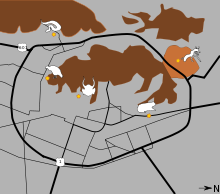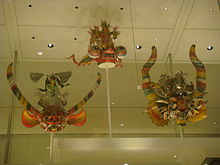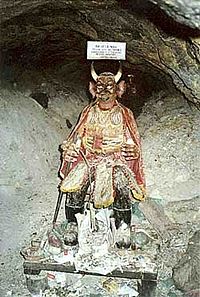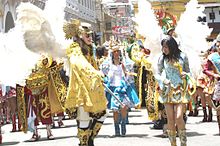- Oruro Diablada
-
Diablada Stylistic origins Spanish culture and Andean music.i Cultural origins Bolivia: Roots in prehispanic Urus traditions with dance of "Llama llama" as most ancient antecedent in the location of Oruro in the first century, from 1789 to the "Devils Comparsa" created for the Virgin of Sócavon, starts the evolution of costume, choreography, plot and music. Finally in 1904 the choreographer Pedro Pablo Corrales institutionalizes the first "Diablada" in the world with the name of the "Great Traditional Authentic Diablada Oruro".
Typical instruments cymbal, bass drum, trumpet, tuba.iii Subgenres Diablada Puneña, Diablada in Chile. Regional scenes Bolivia:
Carnaval de Oruro, Fiesta del Gran Poder, Fiesta de Urkupiña, Fiesta de Ch'utillos, Entrada de la Virgen de Guadalupe among others.The Diablada or Dance de Diablos (English: Dance of the Devils), is a primival, typical and main of Oruro in Bolivia which is mainly represented in the Carnaval de Oruro in honor of the Virgin of Socavón. Characterized by the mask and devil suit wore by the dancers.[1][2] Unlike other similar expressions of the Andes, it is considered to retain most of the artistic expression coming from pre-Columbian America. The dance is a mixture of the Spaniard's theatrical presentations and Andean religious ceremonies such as the Llama llama dance in honour of the Uru god Tiw (their protector in mines, lakes, and rivers),[3].
The dance itself boasts a wealth to the point considered as a "lifestyle." In Bolivia it is considered as a patriotic symbol.
Contents
Origin of the denomination
Oruro Diablada in the Carnaval de Oruro 2007.
The name was consolidated in a historical process of acceptance of the "Dance of devils" Native-Miners to the whole society of Oruro, this process covers the period from 1789 to 1944 where groups of "parades of devils" be called "Diablada." Finally in 1904 created the primeval "Diablada" with the label "The Great Traditional Authentic Diablada Oruro", with music, dress, choreography and plot defined. This period culminated with the founding of new groups of Diabladas in 1944, consolidating the denomination. Currently this definition is in the dictionary of the Spanish Royal Academy of Language.
“ Diablada. f. Typical dance from the region of Oruro, Bolivia, named after the mask and the devil costume worn by dancers. II 2. Mex. prank (II minor mischief.) ” —Dictionary of the Spanish Royal Academy of Language
Origin of the dance
Its earliest record found in pre-Hispanic times, the dance of "Llama llama" dance subsequent ironically devoted Aymara language of the Urus dance dressed as devils, as recorded by Ludovico Bertonio.
With the arrival of the Spanish in this region in 1535 and the Augustinians in 1559 with the Virgin of Candelaria, it begins to produce an acculturation of religions and cultures.
Ethnohistorical development process of disguise and the dance of Diablada fall into three periods, according to the document sent of Carnaval de Oruro to Organization of the United Nations Educational, Scientific and Cultural Organization (Unesco).
- 1606 to 1789: Historical period the founding of the Villa de San Felipe de Austria by Mr. Manuel de Castro Castillo and Padilla in a space called Uru Uru (Hururu now Oruro), which survives in part the cult of Imps ( name called) to "uncle" of mine that is slowly becoming a cult mixed to "Virgin of Socavón (Virgin of Candelaria) - Uncle of mine (Wari)."
- 1789 to 1944: Officially the image of the Virgin would be enthroned as from the date his image venerated by miners would be dressed as devils, including the archangel San Miguel. By 1818 the cure Montealegre Unveils "The Story of the Diablada", in 1891 finally ends the construction of the chapel of the Tunnel. And by 1904 was born the primeval "Diablada" with the tagline of "The Great Traditional Authentic Diablada Oruro." Diablada starting to travel inside and outside the country since 1915 to show its spectacular choreography, music and costume.
- 1944 to 1960: During this period Diabladas form new groups in 1944 such as: Artistic and cultural fraternity the "Diablada", in June of that year the Traditional set Folk "Diablada Oruro" then the "Circle of Arts and Letters." In 1956 he founded the "Diablada Railway" and finally in 1960 the "Artistic Diablada Urus". Diabladas also travel inside and outside the country showing the rich culture of Oruro, resulting in the founding of similar groups in other geographies of the continent.
“ ...The Ito festival was transformed into a Christian ritual, celebrated on Candlemas (2 February). The traditional llama llama or diablada in worship of the Uru god Tiw became the main dance at the Carnival of Oruro... ” —Proclamation of "Masterpiece of Oral and Intangible Heritage of Humanity" to the "Carnival of Oruro", UNESCO 2001
History
Uru roots
After the declaration of the Carnaval de Oruro as one of the Masterpieces of the Oral and Intangible Heritage of Humanity in 18 May 2001, the UNESCO delegated their ex-ambassador in Bolivia, Ivés de la Goublaye de Menorval, the task to be the moderator of the project and handed a form to the Bolivian authorities to be filled in coordination with historians and folklorists, such as Ramiro Condarco Morales, Mario Montaño Aragón, Fernando Cajías, Alberto Guerra Gutiérrez, Javier Romero, Elías Delgado, Carlos Condarco Santillán, Marcelo Lara, Zenobio Calizaya, Zulma Yugar, Walter Zambrana and Ascanio Nava.
The document elaborated by this group is based in the theory that the modern Diablada has roots in the ancient rituals performed 2000 years ago by the Uru civilization. The study makes reference to a deity named Tiw who was the protector of the Urus in mines, lakes and rivers and, in the case of Oruro (or Uru-uru), the owner of caves and rocky shelters. The Urus worship this deity with the dance of the devils being the Tiw himself the main character, later this name was hispanicized as Tío (English: uncle), and as product of the syncretism, the Tiw represented the figure of the devil regretting and becoming devotee of the Virgin of Socavón.[4]
During the times of the Tahuantinsuyu, the four administrative entities known as suyus had their own representative dances during the Ito festival, a festivity once celebrated throughout the entire empire but, according to the historian José Mansilla Vázquez, who based on manuscripts of Fray Martín de Murúa, says that these festivities were outlawed during the Viceroyalty of Peru with the exception of Oruro which, for being considered an important miner city in the 16th century, counted with some privileges and the Spanish authorities looked to the other way allowing this festivity persist in this city, adapting itself later into the Spanish traditions between the Carnestolendas and the Corpus Christi becoming into the Carnaval of Oruro over the centuries.[5]
 Map of the sacred places in the city of Oruro, Bolivia showing the location of the ants, lizards, toads and snakes, animals considered sacred in the Uru mythology.
Map of the sacred places in the city of Oruro, Bolivia showing the location of the ants, lizards, toads and snakes, animals considered sacred in the Uru mythology.
The ancient authors, Fray Martín de Murúa and Felipe Guaman Poma de Ayala make reference in their works to the different dances of the area, including the dance of the Llama llama, name given by the Aymaras to refer to the Urus dressed as dancing demons, as it was recorded by Ludovico Bertonio. This dance was performed during the Ito festivities by the representatives of the region known as Urucolla, a sub-region of the south-eastern suyu of Collasuyu located in the lake system of the Department of Oruro between the basins of the lakes Poopó and Coipasa, where the Uru civilization had the city of Oruro as their main social centre, becoming together with Nazca and Wari one of the most ancient cities in the Andean world.[5][6]
The supporters of this theory consider that the Uru mythology is reflected in the symbolism of the Diablada. The legend behind the importance of the city of Oruro as an ancient sacred place for the Urus tells the story of the chthonic deity Wari, which in the Uru language means soul (Uru: hahuari). He, after hearing that the Urus were worshiping Pachacamaj, represented by Inti, unleashed his revenge by sending plagues of ants, lizards, toads and snakes, animals considered sacred in the Uru mythology. But they were protected by the Ñusta who adopted the figure of a condor, defeating the creatures petrifying them and becoming sacred hills in the four cardinal points of the city of Oruro; these animals are also often represented in the traditional masks of the Diablada.[7][8][9]
Spanish influence
One of the most referenced studies about the Diablada is the 1961 book of Julia Elena Fortún, La danza de los diablos (The dance of the devils), in which the theory of a relationship between this dance and a Catalonian dance named Ball de diables, was suggested; more specifically with the elements used in the localities of Penedès and Tarragona.[10][11] Julia Elena Fortún, unlike other historians in the Peruvian side, disagrees with the idea of considering the Diablada as a product of the introduction of the autos sacramentales in the Andes, because among the ones studied by her, the thematic of the devil and his temptations was not contemplated.[12]
Ball de diables theory
The Ball de diables has origins in a 12th century entremés representing the struggle between the good and the evil where the figure of the archangel Saint Michael and his angels battled the forces of evil represented by Lucifer and his demons. This act was performed in the wedding banquet of the Barcelona count, Ramón Berenguer IV with the princess Petronila, daughter of the king of Aragón and Catalonia in the year 1150.[11]
In a study presented in 2005 by the Catalonian scholar Jordi Rius i Mercade, member of the Ball de Sant Miquel i Diables de la Riera (board of the Ball de diables in Spain) and editor in chief of the specialized magazine El Dragabales during the Symposium of the Catalonian Discovery of America, states that the traditional dances and short plays performed during the celebration of Corpus Christi in Spain were adopted by the Christian church to teach their doctrines to the native Americans; their festivities were readapted to the new calendar and their deities were redefined acquiring demoniac forms representing the evil fighting against the divine power. According to Rius i Mercade, the Ball de diables was the most suitable for this purpose. In this study, he identifies three Latin American dances that contain similar elements to the Catalonian Ball de diables; the Diablada of Oruro, Baile de Diablos de Cobán in Guatemala and Danza de los diablicos de Túcume in Peru.[11]
The Diablada of Oruro represents the tale of the struggle between the archangel Saint Michael and Lucifer, the she-devil China Supay and devils accompanying them. Ruis i Mercade suggests that this was a tale presented by the parish priest Ladislao Montealegre of the city of Oruro in 1818 inspired in the Catalonian Ball de diables.[11]
Colonial history
During the colonial times in the region, from the 15th century till the first half of the 19th century, the ancient Andean beliefs were blended with the new Christian traditions. The traditions adopted new iconography and the celebrations adopted a new meaning during the Latin American wars of independence.
Independence and the transition to the Carnival
 Different models of Diablada masks in an exhibition in the British Museum.
Different models of Diablada masks in an exhibition in the British Museum.
The cult of the Virgin of the Candlemas, was then spread throughout the Andes reaching, Oruro and to the west to Puno. In Oruro there is a Sanctuary in honour of the Virgin of Socavón (or Sanctuary of the Virgin of the Mineshaft) who was originally the Virgin of Candlemas traditionally honoured on 2 February, like in Puno, but later the date was moved to Carnival; this transition is product of the Bolivian War of Independence. [13]
There is a legend that says that on the Saturday of Carnival in 1789 a bandit known as Nina-Nina or Chiru-Chiru was mortally wounded in a street fight and before dying he was confronted by the Virgin of the Candlemas. Some versions state that he used to worship a life-size image of the Virgin painted in a wall of a deserted house, some say that the painting miraculously appeared on the wall of the bandit's own house after his death. And the legend is concluded with the tale of the troupe of devils dancing in honour of the Virgin in the next year's Carnival. The present sanctuary in Oruro was completed in 1891.[13]
However according to the Ph D in religious studies and Executive Director of the Wisconsin Humanities Council at the University of Wisconsin-Madison, Max Harris, this legend is related to a historical reality. During the Rebellion of Túpac Amaru II, which started in Cusco and spread along the Andean highlands, Oruro experienced a brief but bloody revolution as well. Pushed by the fear of being target of the indigenous revolution, the majority Creole on the night of Saturday, 10 February 1781, attacked the minority ruling class of the peninsular-born Spaniards (Spanish: chapetones) . With the arrival of the Indigenous army the Creoles made an alliance.[13]
On 15 February, a messenger arrived in Oruro with orders from Túpac Amaru II. He instructed his army to respect churches and clergy, to do no harm to Creoles, and to prosecute none but chapetones. And assured the victory by entering in La Paz "by Carnival (por Carnestolendas)", the Indigenous occupation of Oruro started to retreat leaving several thousands of deaths. But during March and April they launched more attacks to the city this time against the Creoles and the remaining Spaniards who unified forces to repel them.[13]
Harris observes that the Carnival of the year of 1781, fell on 24 February, placing Oruro's occupation exactly halfway between Candlemas and Carnival, making the situation in Oruro in Harris' words, "carnivalesque". Religious processions duelled with secular parades. Europeans and Creoles disguised as Indigenous, cases like a Spaniard resorting to cross-dressing tin a vain attempt to save his life and thousands of armed men in the streets of the colonial city. By 19 February people in the city regardless of the conflict continued celebrating and, throughout Carnival, the city markets were full of robbers selling the looted gold and silver back to its owners or to cholos and mestizos. By 1784 it was customary to rejoice, dance, play, and form comparsas (companies of masqueraders) for the Carnival in Oruro.[13]
Harris considers that with this background is that the legend of the Virgin of the Mineshaft in 1789 appeared favouring the rebellion as they worshiped the Virgin of Candlemas while the chapetones used to worship the Virgin of the Rosary. Under the beliefs of the revolutionaries, the Virgin of the Socavón tolerated the indigenous deities or devils and, according to Harris, if the legend is correct, by 1790, Oruro's miners had moved Candlemas to Carnival and added indigenous gods, masked as Christian devils, to the festivities.[13]
In 1818, Oruro's parish priest, Ladislao Montealegre, wrote the play Narrative of the seven deadly sins, where according to Harris and Fortún, borrowed elements of the Catalonian Ball de diables like the female devil, Diablesa in the Catalonian dance and China supay in the Diablada and where the Devil leads the Seven Deadly Sins into battle against the opposing Virtues and an angel. Harris suggests that Montealegre may have wanted to represent the threat of rebellion and the historical context with this play.[13]
A generation later, in 1825 after Bolivia achieved its independence, the Diablada and the Carnival adopted a new meaning for Oruro's residents. Two of the Diablada dance squads and the street from where the parade starts are named after Sebastian Pagador, one of the Creole heroes of the uprising. And the main square which is in the route of the Carnival to the Virgin of the Mineshaft temple is named Plaza 10 de febrero (10 February square) remembering the date of the uprising.[13]
The dance
Diablada dancer from the Carnaval de Oruro.
Oruro Diablada dances belong to "masked" most popular of the Bolivian highlands. It is interpreted as the start of the carnival or in processions in honor of a saint "fraternities", groups that incorporate, in some cases, several hundred participants. Moreover, this dance is understood as "the victory of good over evil." All the creation myths of Oruro diablada reference samples and there are paintings that allude to the dance from the time of pre-Columbian America. There are two important types of myths: one related to the town of Urus, one of the oldest ethnic groups in South America. Their descendants, about 1500 and known as Uru-Chipaya, live near Lake Poopo in Oruro, in the Puno region, where they also have a few individuals belonging to that people. According to oral tradition, these people were saved by the appearance of the "divine nusta" Inti Wara who freed them from the plagues sent by the wrath of the fearsome god Huari (Wari). The other myth creators reveal the relationship between Chiru-Chiru / Nina Nina, a sort of "Robin Hood Andean", and the Virgin of Candelaria or Our Lady of the Tunnel whose image appeared "miraculously" in a silver mine in the late eighteenth century.[14] Another benchmark are the riches hidden inside the mines and the related exploitation by the miners.
Choreography
The Diablada is accompanied by band and orchestra. The uniformity of the suits brought choreographic innovation, with the layout of steps, movements, and figure designs that are not only ready to be staged in open areas such as roads, streets, and public squares; but also in places such as theaters and arenas. At the start of the krewe are Lucifer and Satan with several China Supay, or devil women. They are followed by the personified seven deadly sins of pride, greed, lust, anger, gluttony, envy, and sloth. Afterwards, a troop of devils come out. They are all led by Saint Michael, with a blouse, short skirt, sword, and shield.
During the dance, angels and demons are constantly moving around while forming somewhat complex figures such as crosses and circles. This confrontation between the two sides is eclipsed when Saint Michael appears, battles, and defeats the Devil. Both characters are dressed in heavy costumes that are highly ornate and finely wrought. The weight of the costume is more of a challenge than an obstacle for the different dance groups. The dancers often attempt to make unique and complex choreographies. The result is a colourful dance, creating a show very much appreciated by the public.
The choreography have three versions, each conformed by seven moves.[15]
First version
- Greetings: The dance starts with formations and greetings to the Virgin. The characters are displayed in two columns with the evil characters (Satan, Lucifer and China Supay) to one side, the Archangel Saint Michael to the other and the Condor in the middle. In formation they greet the rest of the devils to both sides.
- Movings: The devils start their greetings in groups of four jumping bouncing on one or other foot.
- Crossings of devil's step: S-shape crossings in couples and individuals.
- Curl: One column starts a spiral advancing to the centre then the other. Satan and Lucifer stand in the shoulders of several devils to tell their tale.
- Star: Represents the rebellion of the rest of the devils against the angel. The figure represented is an inverted Pentagram as the Sigil of Baphomet or the Signature of the Devil. Once the devils are knelled the angel enters marching.
- Star banish: Once the angel says "Oh evil spirits, get out of these places" the star is dissolved, the angel pronounces a speech and the devils representing the seven deadly sins confess towards the angel whoo says "Against arrogance" and the devil yells "Humility!" and regretful and with the head low retires to his row, once the sins are defeated the devils are under the command of the angel and the triumph or joy dance is interpreted.
- Squads: Formations with jump-step in rows of four, three, two, and one in front of the angel.
Second version
- Movings: In each column there are two leaders named guides or back-guides. The Archangel Saint Michael directs the moves with a whistle, to its signal the devils come from outside to the place of the angel while the China Supay, Satan and Lucifer switch places with him. To the second signal the devils do the same move but jumping. In the centre there is a complementary character such as the bear or condor.
- Curl: The spiral is formed and the guides or back-guides hold Satan in their shoulders who pronounces his speech. Then the band plays a slow march and the angel enters with martial step and with a cross and a mirror dazzles the devils and they return to their original places.
- Street: There is a representation of the struggle between Lucifer and the angel who wins, then Satan comes to defend his friend and is defeated too. Finally the she-devil China Spuay representing sin and flesh comes and is defeated as well. Then the angel returns to his original position.
- Squads: The China Supay and the angel on one side and Lucifer and Satan to the other dancing make switches and the devils greet them in groups of four and two.
- Star: The shape is formed and with the signal of the whistle the devils kneel, the band plays a slow march and the angel enters to the centre and the star is dissolved calling to the seven deadly sins who defeated go back to their places. Then the guides switch places.
- Chain: The dancers do a double chain and dancing holding by their arms first with the right arm then with the left one and going back to their places.
- End: The devils go to the centre in groups of four, three two and one finishing the show.
Third version
The third version is the one performed by the squad Gran Tradicional y Auténtica Diablada Oruro.[15]
Introduction Devil's walk: The devils in the left column start the movement while the ones in the right one follow them. Lucifer and Satan are named the "Kings", they are placed behind followed by the Angel and the China Supay and the band to the right side behind the second column of devils. The Kings break the formation followed by the devils, and the Condor and Bear who stay in the middle. Then the Angel and the China Supay go forward passing the middle ones by the side.
- The greet: The Kings in the front corners, the Angel and the China Supay in the back corners, and the Bear in the middle. Each perform a greeting movement.
- Curl: The devils go to the back then the left column go forward and Lucifer who is in the front meets them in the middle while the circle closes around him, he is picked up for his dialogue with Satan or to be cheered.
- Star: The devils form the star then kneel and stand up again.
- By four: The squad advances in groups of four, then breaking the formation retiring themselves to each column.
- By three: The same movement but this time in groups of three.
- By two: Same movement as the two previous ones in couples.
- By one: The devils go to the back by the side followed by the Kings, the angel and the China Supay then advance in zig zag drawing a snake, then leaving the scenario led by the Kings.
Music
 1862 partiture of a Diablada tune named Déjame by the composer Froilán Zevillano of the Poopó Province in Oruro, Bolivia.
1862 partiture of a Diablada tune named Déjame by the composer Froilán Zevillano of the Poopó Province in Oruro, Bolivia.
The music associated with the dance has two parts: the first which is known as the March and the second one named the Diablada Mecapaqueña, some squads play only one melody or start the Mecapaqueña in the fourth movement "by four".[15] Since the second half of the 20th century "the dialogue" is omitted focusing only in the dance.[16]
To see and hear
See also
References
- ^ Page 63
- ^ Real Academia Española (2001). "Diccionario de la Lengua Española - Vigésima segunda edición [Spanish Language Dictionary - 22nd edition]" (in Spanish). Madrid, Spain. http://buscon.rae.es/draeI/SrvltConsulta?TIPO_BUS=3&LEMA=diablada. Retrieved 30 November 2009. "Danza típica de la región de Oruro, en Bolivia, llamada así por la careta y el traje de diablo que usan los bailarines (Typical dance from the region of Oruro, in Bolivia, called that way by the mask and devil suit wore by the dancers)."
- ^ "Bolivia (Plurinational State of) - Information related to Intangible Cultural Heritage". UNESCO. 2001. http://www.unesco.org/culture/ich/index.php?lg=EN&cp=BO. Retrieved 3 October 2009. "The town of Oruro, situated at an altitude of 3,700 metres in the mountains of western Bolivia and once a pre-Columbian ceremonial site, was an important mining area in the nineteenth and twentieth centuries. Resettled by the Spanish in 1606, it continued to be a sacred site for the Uru people, who would often travel long distances to perform their rituals, especially for the principal Ito festival. The Spanish banned these ceremonies in the seventeenth century, but they continued under the guise of Christian liturgy: the Andean gods were concealed behind Christian icons and the Andean divinities became the Saints. The Ito festival was transformed into a Christian ritual, celebrated on Candlemas (2 February). The traditional llama llama or diablada in worship of the Uru god Tiw became the main dance at the Carnival of Oruro."
- ^ A.C.F,O. 2001, p.3.
- ^ a b A.C.F,O. 2001, pp.10-17.
- ^ Guaman Poma de Ayala 1615, p.235.
- ^ Claure Covarrubias,Javier (January 2009). "El Tío de la mina [The Uncle of the mine]" (in Spanish). Stockholm, Sweden: Arena y Cal, revista literaria y cultural divulgativa. http://www.islabahia.com/arenaycal/2009/156_enero/javier_claure_156.asp. Retrieved 13 January 2010.
- ^ Ríos, Edwin (2009). "Mitología andina de los urus [Andean mythology of the Urus]" (in Spanish). Oruro, Bolivia: MiCarnaval.net. http://www.micarnaval.net/mitologia.htm. Retrieved 13 January 2010.
- ^ Ríos, Edwin (2009). "La Diablada originada en Oruro - Bolivia [The Diablada originated in Oruro - Bolivia]" (in Spanish). Oruro, Bolivia: MiCarnaval.net. http://www.micarnaval.net/origen_diablada.htm. Retrieved 13 January 2010.
- ^ Fortún 1961, p. 23.
- ^ a b c d Rius I Mercade 2005
- ^ Fortún 1961, p. 24.
- ^ a b c d e f g h Harris 2003, pp. 205-211.
- ^ Qué fantástica esta fiesta. La Tercera.
- ^ a b c Fortún, Julia Elena (1961). "Actual coreografía del baile de los diablos [Current choreography of the devils dance]" (in Spanish) (DOC). La danza de los diablos [The dance of the devils]. Autores bolivianos contemporáneos. 5. La Paz, Bolivia: Ministerio de Educación y Bellas Artes, Oficialía Mayor de Cultura Nacional. OCLC 3346627. http://ww2.atlasdeladiversidad.net/docs/escuelas/escuela322/gruposclase/grupoclase830/retratos/retrato13056/actual_coreografia_de_la_diablada.doc.
- ^ Gisbert 2002, p. 9.
Categories:- Bolivian dances
- Bolivian culture
- Masterpieces of the Oral and Intangible Heritage of Humanity
Wikimedia Foundation. 2010.







